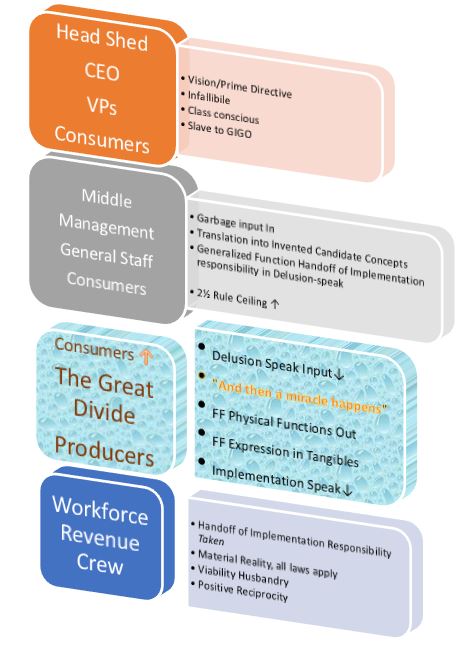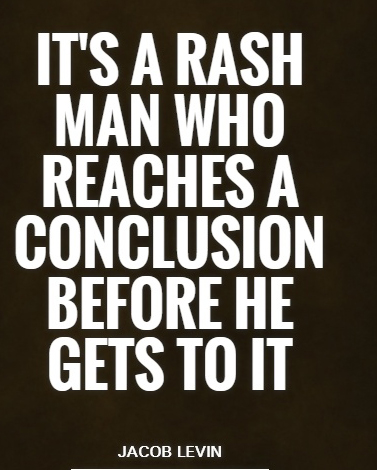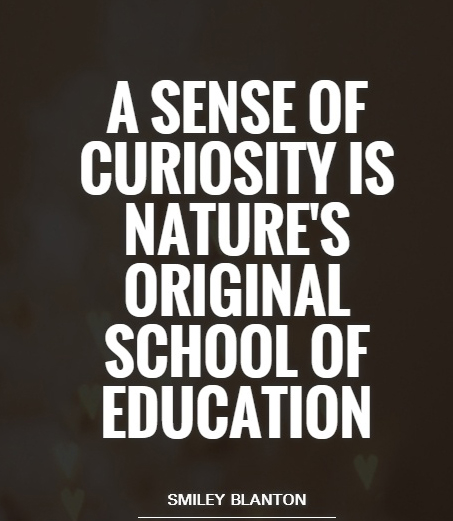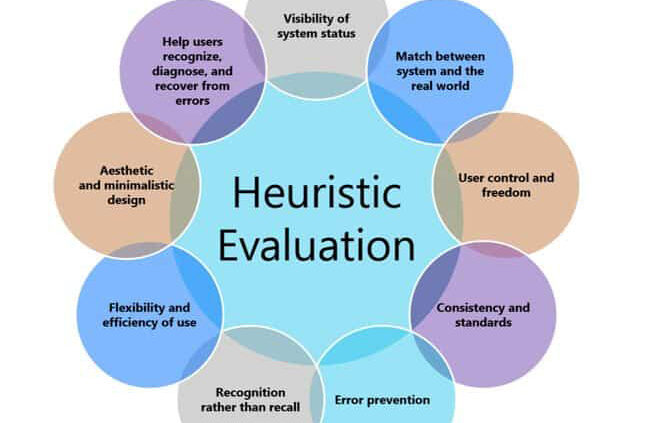It’s all, only, and always about trust
The hallmark of Plan B is high-stakes trust. It is the glue that holds extraordinary collaborative performance together through time. It is the lubricant of the social transactions that have to take place. It is the social power amplifier.
Nature has trust determined by your subconscious mind set up as a dependent variable. It computes two variables, health and GYAT, and then combines their scores to arrive at a level of trustworthiness. You can’t fool another person’s subconscious mind any more than they can fool you.
Plan B is a trust-based ecological system, maintaining the high level of trust Plan B requires the workforce producers have to have their acts together. To get your act together (GYAT) requires good psychological and physical health. GYAT is a royal PITA, consuming lots of internal energy for learning and implementing choices. Right now most of your limited supply of energy is occupied dealing with the consequences of fear-driven angst. Process objective number one of Plan B is releasing this health energy back to you for more worthwhile uses.
There are no all-purpose psychological fixes. Personal variation prevents it. There are generic goals for each audience class, but no all-occasion pathway to arrive there. The FLLP is customized for each participant. We abide the Platinum Rule, not the Golden Rule.
Psychological health comes from setting your subconscious on a more reality and less fantasy track. You curtail its influence on your actions by using conscious-mind veto and override of its imperatives.
While you can’t change subconscious mind’s triggers and speed, over time you can change the algorithms it uses by conscious-mind overrides. Veto means “no” to your subconscious.
To best grasp its mechanisms of action, it is necessary to understand how the individual nodes of the social network make task-action choices. Human selection of effort, an act of intelligence was the place to begin learning.
Social behavior itself originates from a network of entangled subconscious minds. Network functioning aggregates and integrates the individual choices. There is no overlord mastermind determining the social behavior exhibited.
Human behavior, social behavior, is all about the selection of actions to take and the amount of effort involved in their execution. Both the selection of what to do and the allocated level of effort to do it are determined by your nervous system wheelhouse in your subconscious brain. To appreciate how and why an individual picks a particular course of action over another, it is incumbent to learn how our genome-endowed brain makes choices for controlling your actions. If you think that your conscious attention and task action choices are entirely under the control of your conscious mind, always rational and in your best interests, we will pray for you.
For planning purposes, subconscious mind is the imprudent, irrational, illogical you. Your conscious mind rationality has to gatekeep the imperatives issues by your subconscious mind, which always goes first.
The ladder of validity
- When a man is in the Robinson Crusoe state of affairs, his intellectual machinery is pre-wired for meeting the occasion. His autopilot choice system, instincts and all will serve him well in survival mode. Reality meets human ingenuity and instinct at its best. He knows that being irrational with Nature will bring him calamity.
- When a man is in the Master/Apprentice social relationship, he is also well served by his mental faculties, as issued. Both men will make reality-centered choices for task action appropriate for membership in the guild. Error detection and correction, cheek by jowl, is local, quick and effective.
- When the organization has three or more layers of hierarchy, powerful new behavior-shaping forces of Nature emerge and take control of its behavior. Plan A, no longer organizationally neutral, sweeps all prior bets off the table. Natural law, overriding human druthers, turns Plan A on autopilot toxic to your interests and that of the social system you rode in on. Why else would the life span of new businesses be so short? Through time they progress from a context congruent with their genetic endowment to a context that strangles their genome social competency.
The sinister, built-in failure mode of intuition in hierarchical conditions acts to cripple the organization long before it wakes up to its progressive degeneration. The only mitigation possible requires consciously taking responsibility for stopping the hemorrhage of resources and the drain on your wellbeing. It means keeping your conscious mind ON to gatekeep never-OFF intuition. The supply of brain glucose getting across the blood-brain barrier becomes a significant factor.
The necessity for starting with individual choice-making becomes apparent when you learn how, exactly, you are making task action choices on autopilot, subconscious functioning without your permission or your knowledge.

The mathematical physics toolbox
The fundamental measure of social behavior begins with stability of the system. If the system is unstable, its behavior and the time of its implosion cannot be predicted. To determine stability, it is necessary to resolve the complexity, using structure, and learning the characteristic equation of the social system. The roots of the characteristic equation are necessary to know whether the control system is stable or unstable. The natural law of control theory determines that if at least one root of the characteristic equation exists to the right half of the ‘s’ plane, then the control system is unstable. As hierarchy increases, it is more difficult to find the roots of the characteristic equation. At three levels of hierarchy, the characteristic equation makes a dramatic, abrupt change (GIGO).
The interesting aspect of this toolbox is that while individual stability equations vary with the individual, the characteristic equation of the hierarchy is invariant. The champion of control theory applied to social system behavior is Rudolf Starkermann. He proved that industrial process control physics applied one for one to social behavior. Predicting individual behavior is problematic, while predicting social behavior is ridiculously easy (Starkermann.com).

Your machinery of intelligence
Your powerful subconscious mind, is allocated 90% of the genetically-endowed computing resources that Nature made available and its business as usual is ON in perpetuity. Since unknowable intuition is on autopilot, we don’t know when or how it processes information and makes choices. It is known that it completes his decision process, from trigger event to action choice in less than a centisecond. Since the information he stores in memory for such purposes is garbage, his output is garbage2. Intuition is thereby a GIGO-powered decision factory, 24/7. Its operation is unknowable, it reports to no one, and it is never OFF.
Rational mind is allocated 10% of your thinking resources, ostensibly under your control, and her business-as-usual state is “Stand By,” When motivated out of her energy-saving stupor, rational mind is slow and plodding but it has time to collect and vet data, perform logical operations on it, and evaluate the consequences of her tentative choice of task action before releasing it for implementation. The chances that her choice of action proves to be appropriate for directing goal attainment in the operational reality are orders of magnitude superior to your irrational intuition.
In goal-seeking there are infinitely more ways to get off the track than to stay on it. The mathematics greatly favors choices that will derail the goal-seeking operation, to wit:
In small social groups, individual behavior on autopilot bias that goes against the established norms will be directly and promptly corrected. Deviations are inconsequential because:
- The goal-seeking stakes are too low
- The control process is local and quick
In steep hierarchies, imprudent individual behavior on autopilot bias works to push goal-seeking off the track and:
- The stakes are much higher.
- The control process is effectively frozen in place by rules.
Putting your intelligence to work for you first, then your social system
The goal here is to make things for your Wonderland adventure as objective as possible, so it is productive. Since there is almost as much to unlearn as there is to learn, getting to Plan B is mostly replacement of self-destructive concepts with strategies for flourishing. You cannot impact your social systems until you have health and your act together for yourself.
If there ever was an expedition where starting right with all the necessary provisions was vital to success, including a desire and capacity for learning, exploring the social behavior of steep hierarchies wins the prize. There is a high premium on hyper-learning the fundamentals upfront. No one can learn them for you. The first milestone is to identify and rid yourself of the psychological baggage blocking your path, your defensive routines covering up for allowing the bad choices of intuition to be implemented. British research reports that 96% of their population makes most of its important decisions on subconscious autopilot. God save the Queen.
Make the unlearning phase more fun than traumatic, even if you’re not a MitM. This is the reason for treating hierarchical social behavior as the product of lunatics it is. If you try to make sense out of the psychopathology, you remain in the asylum with them. Everything in the arena of social behavior is psychological. There are no tangible goods. No free-trade zones.
When you let the establishment hordes hijack your subconscious brain by its savvy media, none of your crafted excuses for allowing it matter.
Step one towards the Plan B experience, then, is to extract the archaic mental models of reality implanted during your socialization that thwart learning about “inconveniently true” operational realities of multiply society. If you think management/leadership is a rational activity performed by rational people according to sensible organizational objectives, abandon all hope.
As you know from experience, social conditioning prepared you for hunter-gatherer tribal life, for master/apprentice social living, not for dealing with steeply-layered organizations hellbent on your psychological and physical destruction. Because the top levels of hierarchy are insecure, plagued by the impostor syndrome, because their authority does not translate into positive social power, they establish class distinctions in direct proportion to their social status anxiety, using punishment of the lower classes with legal impunity.
This journey requires loading the coping essentials you don’t know in your backpack, including:
- The objective definition of social system you can put to practical use
- The mechanisms of action that distinguish a social system from a mob. Prudent and Imprudent.
- The mechanisms of action that distinguish a self-correcting social system. Always prudent.
- The marriage between social behavior and individual intelligence.
- The subconscious mind on autopilot. Invariably imprudent.
- The functional scope and influence of hierarchical social systems
- The tangible elements
- The intangible elements
- The network interdependencies
- Social intelligence of the hierarchy
- Susceptibility of your mind to hacking by your adversaries in the know
- The happy, attainable way-of-life alternatives to the standard, toxic performance of hierarchy. Visit a stable, secure, and prosperous implementation that you can audit face-to-face to resolve your concerns.
- The process of going from the grim autopilot situation (Plan A) to a flourishing alternative (Plan B). It is setting your defensive routines aside while offensive practices take over operations.
- The intrinsic role of the man-in-the-middle – aka keystone, vector, foreman, workmaster, linchpin, as the prime mover of a flourishing organization. He goes from a trapped victim of Plan A to a happy state of (Maslow) self-actualization. The keystone is keystone because his is the only role in the hierarchy that can take legitimate responsibility for the performance of and the outcome consequences of his revenue crew. It is identical to the master/apprentice relationship of antiquity.

Everyone, ourselves included, who begins the hyperlearning phase that fixes these cognitive potholes is entering the provisioning depot as “psychologically-damaged” goods. A place is needed in your central nervous system to attach the truth. There’s nothing brave about fighting a hopeless situation.
Notice those acting around you. They are navigating social life by blind drift – mindlessly taking the path of least organizational resistance as silently dictated by intuition, autopilot dysrationalia. In these turbulent times of change, striving for steady-state is a self-defeating policy. With no destination coordinates and no GPS, the Second Law of thermodynamics heaps disorder on disorder across their path until they are captured by the very hell they sought to avoid. If that’s not social system psychosis, what is?
An example
As you experience, the Establishment promotes the sciences of psychology and sociology because those disciplines supply the biases and blind spots the privileged class uses to control, through silicon valley, the task action choices of the masses – without their awareness. To participate in social media today is to accept abuse by people you don’t even know and never meet.
One of the exploitation techniques in use by the Establishment today uses the autopilot bias of people to default choice of action to the authorities in direct proportion to their level of fear. To gain a sense of power and control, authorities implant and amplify fear with propaganda, using such events as COVID to invoke the pattern. The authorities threaten the population with all manner of punishment for violating the rules, adding to their level of fear. While the Establishment enjoys their delusions of omnipotence, the people, now a bait ball, suffer terrible consequences to their health and welfare.
Some American cities are now being destroyed for the sole purpose of their elected officials getting a thrill of unbridled power and control. It’s a temporary thrill, to be sure, but it causes massive amounts of damage to the citizens. The best contributors to the city, those that engineer general prosperity, are the first to leave the area. Dysfunctional societies cannot self-correct. They cannot buy their way out of their decline.
We are apparently now in a situation where modern technology is changing the way people behave, people talk, people react, people think, and people remember. And you encounter this not only in a theoretical way, but when you meet people, when suddenly people start forgetting things, when suddenly people depend on their gadgets, and other stuff, to remember certain things. This is the beginning, it’s just an experience. But if you think about it and you think about your own behavior, you suddenly realize that something fundamental is going on. Frank Schirrmacher
Intelligence
Social behavior change for the better can only be produced by applied intelligence. That means the MitM is voluntarily taking responsibility for operational performance. If the participants in the collective exercise prudence, perforce using their conscious minds, the transactions are always fruitful. If intelligence is not applied in the choice of actions going forward, autopilot imprudence brings bad-choice consequences. The connection between fruitful social behavior, prudence, and intelligence is absolute. Upgrading your repertoire is the only way to outwit your antagonists.
There is only one incontrovertible definition of human intelligence. In 1932, William Ross Ashby defined intelligence as “appropriate selection.” He claimed that a person who routinely makes selections that invariably attain his goals (therefore appropriate) cannot be called unintelligent, no matter his credentials and test scores. Likewise, if a person predictably takes action that consistently fails to realize his stated objectives, he cannot also be called intelligent. Credentials do not overrule performance. That stipulation alone condemns the irrational functioning of your intuition as imprudence.
Hierarchical behavior on autopilot cannot also be intelligent. Taking the imperatives issued by the unknowable subconscious mind and its data bank of fiction and acting on them because it takes no cognitive exertion, can only lead to system disaster.
PBS recently produced a NOVA documentary (2021) on slime mold (no brain) that perfectly highlights Ashby’s concept of intelligence. All other definitions of intelligence fail the slime-mold test. In practice, humanity handles the duty to define intelligence by not defining it at all. Ashby’s definition of intelligence is a universal law. It applies to all human activity.
The simple fact that an organization is flourishing means that it is prudent, intelligent. You can tell because maintaining prosperity is a primary activity, conscious mind always ON.
Only the conscious mind and its plodding 40-bit per second computer can take the time it takes to be intelligent, to appropriately select, to consistently attain stated goals. When you observe social behavior you are witnessing human intelligence, or lack of it, in action. Manifest social behavior is either orchestrated by your subconscious or by your conscious mind set on gatekeeper mode. There is no third pathway.
In this way, the study of human choice-making, social intelligence, prudence, and hierarchical behavior are one and the same thing. Grasp the functionality and limitations of human intelligence to understand social behavior, especially when it is on business as usual.

Silence-breaking for exercising curiosity
Hyperlearning about Plan B entails silence-breaking. It’s stuff you already know that has been deemed undiscussable by your defensive collective (Argyris). The acquisition of insight to prudent allocation of effort is a precondition for positive change. Discussing the undiscussables speeds the process. The long list of the taboo topics in groupthink (Plan A) includes issues such as prudence, leadership dysrationalia, social status domination, and your inalienable rights.
We silence-break to get your attention, but only you can remove the wreckage strewn across your learning path. This website is loaded with silence-breaking, truth-telling. These are examples of offensive vs defensive routines. Defensive routines by intuition don’t work in the operational reality.
In the Front Line Leader Program (FLLP), the change process that overwrites Plan A with Plan B, every episode includes silence-breaking. It brings rapt attention and furious note taking. Seven seasons, six episodes each, delivers over 100 distinctive jolts of semi-hidden reality. Visit any episode and you can witness the hyperlearning magic for yourself. It’s not just that the truth will set you free, but you do it for your own psychological health. The fiction of steady-state defense doesn’t work, because it ends up adding to the paralyzing fear and fear automatically triggers bait-ball obedience to authority. Exploited by authoritarians, the logical fallacy is the dirtiest trick nature plays on our species.
Unlike the well-publicized trauma of “cultural change” marathons for the top-down mindset, the FLLP is a trauma-free happy experience from day one. There is no pressure or pain for anyone in the sprint to Plan B. The interventionist sets up an audience-run demo in Episode One of Season One that has things rollicking in less than two minutes from kickoff. Apprehension dissolves and the fun never stops. You witness the hyperlearning best by participating yourself. For an audience of MitMs, silence-breaking releases the fun in dysfunctional.
Being open to learning means being free of path-blocking misperceptions. Since unlearning the rubbish of status quo defense takes time and internal energy, Plan B learning can’t start until your angst reservoir pressure is vented-off. Angst blowdown, when it comes, comes as a whoosh, instantly releasing the supply of internal energy required for getting to Plan B. In the FLLP, angst extraction occurs before episode three of season one. People smothered on angst cannot help themselves get better. They remain dead in the water.
Yes, there’s an awful lot of socially-ingrained stuff to unlearn and a bunch of taboo stuff to discuss and ingest. If you can keep focused on the benefit package payoffs and not the protracted cognitive load, it will do wonders for your self-image. Getting immediate payoffs for thinking for yourself is addictive.
There is a large amount of relevant history on Plan A, starting at the dawn of civilization. While there is a history of Plan B instances as well, at the time of their fleeting occurrence, nobody knew there was such a thing as a Plan B. If you leave out the million books on management and leadership, zero relevancy, there is still a million pages of pertinent history. You can have a thumb drive of this social system legacy, 16G of .pdf files, searchable, just for the asking (Contact Us).
A sovereign cannot raise an army because he is enraged, nor can a general fight because he is resentful. For while an angered man may again be happy, and a resentful man again be pleased, a state that has perished cannot be restored, nor can the dead be brought back to life. Therefore, the enlightened ruler is prudent and the good general is warned against rash action. Thus the state is kept secure and the army preserved. Lao Tzu
Views: 129


